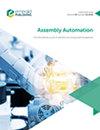The job rotation scheduling problem considering human cognitive effects: an integrated approach
IF 1.7
4区 计算机科学
Q3 AUTOMATION & CONTROL SYSTEMS
引用次数: 1
Abstract
Purpose This paper aims to unfold the role that job rotation plays in a lean cell. Unlike many studies, the authors consider heterogeneous operators with dynamic performance factor that is impacted by the assignment and scheduling decisions. The purpose is to derive an understanding of the underlying effects of job rotations on performance metrics in a lean cell. The authors use an optimization framework and an experimental design methodology for sensitivity analysis of the input parameters. Design/methodology/approach The approach is an integration of three stages. The authors propose a set-based optimization model that considers human behavior parameters. They also solve the problem with two meta-heuristic algorithms and an efficient local search algorithm. Further, the authors run a post-optimality analysis by conducting a design of experiments using the response surface methodology (RSM). Findings The results of the optimization model reveal that the job rotation schedules and the human cognitive metrics influence the performance of the lean cell. The results of the sensitivity analysis further show that the objective function and the job rotation frequencies are highly sensitive to the other input parameters. Based on the findings from the RSM, the authors derive general rules for the job rotations in a lean cell given the ranges in other input variables. Originality/value The authors integrate the job rotation scheduling model with human behavioral and cognitive parameters and formulate the problem in a lean cell for the first time in the literature. In addition, they use the RSM for the first time in this context and offer a post-optimality analysis that reveals important information about the impact of the job rotations on the performance of operators and the entire working cell.考虑人类认知效应的工作轮换调度问题:一种综合方法
本文旨在揭示岗位轮换在精益细胞中的作用。与以往的研究不同,本文考虑了受分配和调度决策影响的异构操作系统的动态性能因素。目的是获得对精益单元中工作轮换对绩效指标的潜在影响的理解。作者使用优化框架和实验设计方法的敏感性分析的输入参数。设计/方法/方法方法是三个阶段的综合。作者提出了一种考虑人类行为参数的基于集合的优化模型。他们还采用了两种元启发式算法和一种高效的局部搜索算法来解决问题。此外,作者通过使用响应面方法(RSM)进行实验设计来运行后最优性分析。结果发现:优化模型的结果表明,工作轮换时间表和人类认知指标影响精益细胞的绩效。灵敏度分析结果进一步表明,目标函数和工作轮换频率对其他输入参数高度敏感。基于RSM的研究结果,作者在给定其他输入变量范围的情况下推导出精益单元中工作轮换的一般规则。原创性/价值作者将工作轮换调度模型与人类行为和认知参数相结合,并在文献中首次在精益细胞中提出问题。此外,他们还首次在这种情况下使用了RSM,并提供了后最优分析,揭示了作业轮换对作业者和整个工作单元性能影响的重要信息。
本文章由计算机程序翻译,如有差异,请以英文原文为准。
求助全文
约1分钟内获得全文
求助全文
来源期刊

Assembly Automation
工程技术-工程:制造
CiteScore
4.30
自引率
14.30%
发文量
51
审稿时长
3.3 months
期刊介绍:
Assembly Automation publishes peer reviewed research articles, technology reviews and specially commissioned case studies. Each issue includes high quality content covering all aspects of assembly technology and automation, and reflecting the most interesting and strategically important research and development activities from around the world. Because of this, readers can stay at the very forefront of industry developments.
All research articles undergo rigorous double-blind peer review, and the journal’s policy of not publishing work that has only been tested in simulation means that only the very best and most practical research articles are included. This ensures that the material that is published has real relevance and value for commercial manufacturing and research organizations.
 求助内容:
求助内容: 应助结果提醒方式:
应助结果提醒方式:


